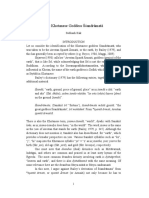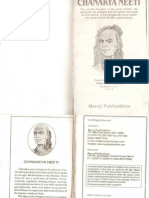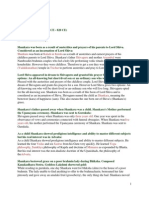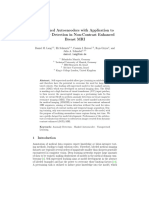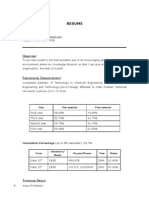Adi Shankara: Shruti Issue: 6
Adi Shankara: Shruti Issue: 6
Uploaded by
koteshbabuCopyright:
Available Formats
Adi Shankara: Shruti Issue: 6
Adi Shankara: Shruti Issue: 6
Uploaded by
koteshbabuOriginal Title
Copyright
Available Formats
Share this document
Did you find this document useful?
Is this content inappropriate?
Copyright:
Available Formats
Adi Shankara: Shruti Issue: 6
Adi Shankara: Shruti Issue: 6
Uploaded by
koteshbabuCopyright:
Available Formats
Adi Shankara
India is known as Veda bhoomi or the land of the Vedas, home to
ancient Sanatana traditions for which Hinduism is known. With the
passage of time, many religions rose and gained strength leading to
the decline and weakening of Vedic traditions. At a time when various
religious dogmas, doctrines and schools were at loggerheads with
each other, the great visionary Adi Shankaracharya came to the rescue
of Hinduism by integrating diverse principles of various traditions of
worship and spirituality.
Adi Shankara became renowned as a man of tremendous knowledge,
incredible wisdom and an excellent debater with a deep insight into
the Vedas. True to the widely accepted notion that God would arrest
the decline of spiritual traditions by taking birth as an Avatara, many
Hindus believe that Sri Shankaracharya was a reincarnation of Lord
Shiva.
Though there are various theories with regard to the age in which
Adi Shankara lived, based on available evidence, it is believed that
he lived in the 7th century AD. Adi Shankara was born to a devout
SHRUTI 1 Issue : 6
6th Eng Shruthi_Kala.indd 1 18-01-2021 11:26:18
Saivite couple, Shivaguru and
Aryamba in Kaladi in the state
of Kerala. His parents named
him Shankara taking him to
be a gift of Lord Shiva’s grace.
Shankara proved to be a
Precocious child. He began to
speak in Sanskrit in addition
to Malayalam in his very first
year. By the time he was two
years old, Shankara could read
and write several languages.
As a three-year-old, Shankara
began to read and explain the meaning of a number of slokas, poems
and puranas.
Adi Shankara’s parents performed his upanayanam when he was
five years old. His father passed away around this time and as a result,
bringing him up became his mother’s sole responsibility. The young
Shankara studied Vedas, Puranas and all the scriptures in the Gurukul
and completed his education by the time he was eight. Shankara was
interested in the deeper study of Vedas. He decided to focus on Vedic
studies setting it as his ultimate goal. Such a mature realisation at this
young age points to Shankara’s extraordinary intellect.
As a boy, Sri Shankara showed great sympathy towards the poor
and the deprived. As per the traditions of the Gurukul, children had
to seek alms and one such occasion, young Shankara went to the
doorstep of a poverty-stricken housewife. Since she had nothing else
to give, she gave him an amla fruit. Moved by this, the young Shankara
it is believed, worshipped Goddess Lakshmi Devi who was pleased
with his prayers and invocations. He appealed to Lakshmi Devi and
filled the poor woman’s house with hundreds of amla fruits made of
gold. Shankara’s life is full of a number of such miraculous incidents.
After completing his education in the Gurukul at the age of eight,
SHRUTI 2 Issue : 6
6th Eng Shruthi_Kala.indd 2 18-01-2021 11:26:18
Shankaracharya returned home
to serve his aging mother. He also
used to spend his time teaching
students. The young Shankara
proved to be precocious beyond his
years and preached about the need
to respect and serve one’s parents as
one’s foremost duty.
Shankara wanted to renounce
the world and become a sanyasi or
ascetic. This was a time when society
was in a state of turmoil due to strong differences of opinion between
various schools of religious belief, which were creating disharmony
among people. Shankaracharya made it his mission to unite people
and realised that this could be done through spiritual awareness alone.
People could not be united through wars or socio-economic reforms,
he felt.
Shankara sought his mother’s permission to pursue this mission,
promising to return when needed, and left Kaladi in search of a
spiritual guru. It was during this time that Shankara came across
Govinda Bhagwatpada, the disciple of the renowned spiritual guru,
Gaudapada. The young student impressed the well-known scholar
with his humility, as also his deep understanding of spiritual matters
and thus became his disciple.
Shankara used to wash his guru’s feet every day and serve him
dutifully. He preached the message that true acquisition of knowledge
can take place only by serving one’s teacher. His teacher explained
to Shankara the essence of the Vedas and Puranas. Based on this
Indulgence in futile talks and concerning
others only distract the mind.
-Sri RamaKrishna Paramahamsa
SHRUTI 3 Issue : 6
6th Eng Shruthi_Kala.indd 3 18-01-2021 11:26:18
Sh an k ar a c h ar y a
propagated the
truism that God
Sringeri Math
is knowledge,
he exists in all
human beings and
Dwaraka Math therefore, all men
are equal. They,
Kanchi Math therefore ought
Puri Math
to be treated with
equal respect.
Shankaracharya
stayed with his guru
Govinda Bhagwatpada for twelve years. On completion of education
he began to work on a treatise on Brahmasutras with the permission
of his guru. For this, he went to the holy temple town of Varanasi
where he attracted large crowds with his oratory. He explained the
complex principles ranging from the Vedas and Upanishads to the
Bhagwad Gita, mesmerising hordes of people who were amazed at the
vast knowledge the young boy demonstrated. He explained the most
difficult concepts in simple terms, and this endeared him to the people
there.
Sri Shankaracharya held debates and discussions with renowned
scholars of Varanasi on the Vedas, Upanishads and Advaita and won
them over with his knowledge and wisdom. Many of them became
his disciples. It is believed that one day, when Sri Shankaracharya was
walking along the banks of the Ganga with his disciples, Lord Shiva
appeared in the form of a Chandala and gave him some advice on
future actions.
Character has to be established
through a thousand stumbles.
-Swami Vivekananda
SHRUTI 4 Issue : 6
6th Eng Shruthi_Kala.indd 4 3 18-01-2021 11:26:19
When Adi Shankara was in Varanasi, a youth came to him seeking
refuge. Sri Shankaracharya made him his disciple and named him
Sananda, who served his Guru with matchless dedication. Adi
Shankara debated with Mandana Mishra, who insisted on the need
and importance of ritualism and proved him wrong. He renamed
Mandana Mishra, who became his disciple, Sureshwara.
Once when Adi Shankara was in GokarnaKshetra, a Brahmin
couple approached him, seeking his blessings for their son, who
was mute. Shankara blessed the child following which, to everyone’s
amazement, the boy began to discuss the philosophy of the soul
with the sage. Sri Shankaracharya initiated the boy into the order of
Sanyasis, made him his disciple and named him Hastamalak.
Sri Shankaracharya toured the four corners of the country on
foot and established four 'mathas' or centres of dharma to spread the
message of spiritualism. They are located at Sringeri, Kanchi, Puri
and Dwaraka. Among the many followers of Sri Shankaracharya,
the principal ones were, Padmapada, Sureshwara (Vartikakara),
Hastamalaka and Thotaka. Adi Shankara appointed them as the
heads of the four matths established by him and asked them to devote
their time to spreading the
message of Dharma.
Realising that his mother
was in her last days, Adi
Shankara travelled to Kaladi.
He began reciting Shiva
Bhujanga Prayata Stotram
and Vishnu Stotram with
the realisation that her end
was near. It is believed that
When knowledge is used for the
benefit of others, it becomes skill and
it brings balance and insight.
-Swami Ranganathananda
SHRUTI 5 Issue : 6
6th Eng Shruthi_Kala.indd 5 18-01-2021 11:26:19
Sri Shankaracharya
performed the last
rites of his mother in
his backyard since his
relatives were reluctant
to come forward and
help him. It is also said
that he ignited the pyre
with the help of fire
invoked by his power
of penance.
Later, Adi Shankara set out on his second round of travels through
India from Rameswaram and reached Sarada Nilayam known as
SarvagnaPeetham in Kashmir. It was said that only a scholar of
complete understanding and knowledge alone was eligible to sit on
this Peetham. On reaching the Himalayan state he held debates and
discussions with eminent scholars from various streams including
Jainism, Buddhism and other schools of thought such as Sankhya,
Yoga, Nyaya and Vaisheshika. Adi Shankara proved his point and won
over all of them with his convincing arguments and sound logic. He
then ascended the SarvagnaPeetham. He was only thirty years old at
that time.
While travelling through India, Sri Shankaracharya visited several
holy places. Through his teachings made many temples do away
with animal sacrifice. He also installed the idols of many gods and
goddesses and to this day, rituals in many shrines are performed
What is done is done..Do not repent, do not brood
over past deeds..you cannot undo, the effect must
come, face it, but be careful never do the same
thing again. – Swami Vivekananda
SHRUTI 6 Issue : 6
6th Eng Shruthi_Kala.indd 6 18-01-2021 11:26:19
as per the norms prescribed by
him. Sri Shankaracharya also
wrote interpretations of the
Bhagavadgita, Upanishads and
Brahmasutras, known together
as Prasthanatrayi. These works
made him very renowned. Sri
Shankaracharya also authored
40 treatises and 74 shorter works
among others. Prominent among
them are Vivekachudamani,
Nirvanashtakam, Manisha
panchakam, the celebrated eulogy
Bhajagovindam, Soundarya Lahari and Subramahnya Bhujanga
eulogy.
After bringing together divergent schools of spiritualism and
being recognised as Jagadguru, Sri Shankaracharya became one
with Brahma at the holy shrine of Kedarnath at the age of 32 years.
The work done by him within this short life span is tremendous to say
the least. Apart from his scholastic contributions, he brought about
unity of all the religious thoughts, established the concept of God
being one though worshipped in different forms by different people,
revived the Vedic traditions and removed the disharmony among the
people of this country. More importantly he re-established the concept
of one nation – Bharatvarsha.
His resting place (samadhi) in the backyard of the Kedarnath
temple, is worshipped by devotees from all over. ]
Don’t carry your mistakes around with you.
Instead, place them under your feet and use
them as stepping stones. – Gauthama Buddha
SHRUTI 7 Issue : 6
6th Eng Shruthi_Kala.indd 7 18-01-2021 11:26:19
You might also like
- The Place of The Hidden Moon PDFDocument2 pagesThe Place of The Hidden Moon PDFAnkit ChoudharyNo ratings yet
- 0 J2008 - Fate and Free Will in The BhagavadgītāDocument8 pages0 J2008 - Fate and Free Will in The BhagavadgītābudimahNo ratings yet
- Jagatguru Adi Sankaracharya's Life ProfileDocument4 pagesJagatguru Adi Sankaracharya's Life ProfileSreepati DasNo ratings yet
- Adi Shankaracharya 2012 5Document23 pagesAdi Shankaracharya 2012 5SairamNo ratings yet
- KamalDocument35 pagesKamalRakesh kaulNo ratings yet
- Kama Samuha IntroductionDocument2 pagesKama Samuha IntroductionRavi SoniNo ratings yet
- Ramana Maharshi's Teachings On Self-LiberationDocument18 pagesRamana Maharshi's Teachings On Self-LiberationLouis FloresNo ratings yet
- Kashmir ShaivismDocument2 pagesKashmir ShaivismsimranNo ratings yet
- Asrar-e-Khudi (Secrets of The Self)Document30 pagesAsrar-e-Khudi (Secrets of The Self)Faizan BashirNo ratings yet
- The Krama Tantricism of Kashmir Vol. I by N. Rastogi Review by Raffaele TorellaDocument3 pagesThe Krama Tantricism of Kashmir Vol. I by N. Rastogi Review by Raffaele TorellaraffaeletorellaNo ratings yet
- The Khotanese Goddess SsandramataDocument7 pagesThe Khotanese Goddess SsandramataStaticNo ratings yet
- Buddhist Book PDFDocument426 pagesBuddhist Book PDFNagesh KumarNo ratings yet
- Bhaj GovindamDocument81 pagesBhaj GovindamSUNIL TANDONNo ratings yet
- AatmabodhaDocument13 pagesAatmabodhaRm SharmaNo ratings yet
- Hindu StotrasDocument2 pagesHindu StotrasAYESHA NAAZNo ratings yet
- Purana Ratnam - Vishnu PuranamDocument19 pagesPurana Ratnam - Vishnu Puranamraj50% (2)
- Abhinavagupta's Use of The Analogyof ReflectionDocument17 pagesAbhinavagupta's Use of The Analogyof ReflectionSatyanarayana HegdeNo ratings yet
- Vedanta The Ultimate WisdomDocument3 pagesVedanta The Ultimate WisdomPrem AbhijitNo ratings yet
- Rediscovering India For IndiansDocument55 pagesRediscovering India For IndiansMalati Gunturi0% (1)
- India What It Can Teach Us Max MuellerDocument128 pagesIndia What It Can Teach Us Max MuellerprakritilayaNo ratings yet
- An Introduction To Sanskrit MetricsDocument7 pagesAn Introduction To Sanskrit MetricsLata DeokarNo ratings yet
- Krishna - The God of Love, Sex and YogaDocument33 pagesKrishna - The God of Love, Sex and Yoganikos nevrosNo ratings yet
- Nama RamayanamDocument13 pagesNama Ramayanamiyer34No ratings yet
- Subhagoday Article 02Document21 pagesSubhagoday Article 02mempj800% (1)
- Ananda Coomaraswamy - Review of Kramrisch's Indian SculptureDocument4 pagesAnanda Coomaraswamy - Review of Kramrisch's Indian SculptureManasNo ratings yet
- Chandragupta MauryaDocument13 pagesChandragupta MauryaHitesh BhatiaNo ratings yet
- ShivSutras by H.H. Sri Sri Ravishankarji - 7 Video Sessions CoveredDocument18 pagesShivSutras by H.H. Sri Sri Ravishankarji - 7 Video Sessions Coveredorchidocean5627No ratings yet
- ParatvamDocument3 pagesParatvamrajNo ratings yet
- Bisschop, Peter and Yuko Yokochi. 2021. The Skandapurana Volume - VDocument314 pagesBisschop, Peter and Yuko Yokochi. 2021. The Skandapurana Volume - VShim JaekwanNo ratings yet
- Bhagwat PuranaDocument452 pagesBhagwat PuranakiruNo ratings yet
- Adi ShankaraDocument29 pagesAdi ShankarasharathVEMNo ratings yet
- Application of Tantrayukti in Research Methodology by Alhad Avahad (Ayurveda)Document7 pagesApplication of Tantrayukti in Research Methodology by Alhad Avahad (Ayurveda)Nilesh Oak100% (2)
- You Are Here: About Terms Privacy Policy Contact Write For UsDocument35 pagesYou Are Here: About Terms Privacy Policy Contact Write For UsThirunavukkarasu SivasubramaniamNo ratings yet
- Okfl"Bdko D.BX - Kifrequs% Xzufkekyk: Collected Works ofDocument189 pagesOkfl"Bdko D.BX - Kifrequs% Xzufkekyk: Collected Works ofBhargavNo ratings yet
- Lalitha LtrisatiDocument11 pagesLalitha Ltrisatideepa2106No ratings yet
- Ahimsa and BuddhismDocument8 pagesAhimsa and Buddhismsd76123No ratings yet
- Ucalgary 2015 Balkaran RajDocument248 pagesUcalgary 2015 Balkaran RajNostalgia234No ratings yet
- Chandragupta MauryaDocument10 pagesChandragupta Mauryansriram786No ratings yet
- Chanakya NitiDocument85 pagesChanakya Nitinitte5768100% (2)
- Vedism and Brahmanism LectureDocument19 pagesVedism and Brahmanism LectureAmit PatwardhanNo ratings yet
- 64 VidyaDocument5 pages64 VidyaPhalgun Balaaji100% (1)
- Devi MahatmyamDocument13 pagesDevi Mahatmyamsundeepmv5483100% (2)
- PRAYASCHITTADocument11 pagesPRAYASCHITTAbabublsNo ratings yet
- B. Baumer - Deciphering Indian Arts KalamulasastraDocument9 pagesB. Baumer - Deciphering Indian Arts KalamulasastraaedicofidiaNo ratings yet
- Kena Upanishad: Brahmanam of The SamavedaDocument9 pagesKena Upanishad: Brahmanam of The Samavedapsrve696No ratings yet
- Tibetan Art of The Alain Bordier FoundatDocument11 pagesTibetan Art of The Alain Bordier Foundatlieungoc.sbs22No ratings yet
- Translation of ĪPK 4.12Document3 pagesTranslation of ĪPK 4.12Chip WilliamsNo ratings yet
- Saivism and The Phallic World Vol 2Document685 pagesSaivism and The Phallic World Vol 2kartikscribdNo ratings yet
- Dhyanayoga in Bagavatgita and Its Relevance in The Modern SocietyDocument5 pagesDhyanayoga in Bagavatgita and Its Relevance in The Modern SocietyVakulaFoundationNo ratings yet
- Agganna SuttaDocument7 pagesAgganna SuttaMindStilledNo ratings yet
- SUTRA VAHINI-By Bhagawan Sri Sathya Sai BabaDocument27 pagesSUTRA VAHINI-By Bhagawan Sri Sathya Sai Babaapi-3824575No ratings yet
- ShankaraDocument4 pagesShankaraSl Bachimanchi0% (1)
- AdishankaraDocument23 pagesAdishankaraRaja O Romeyo NaveenNo ratings yet
- Shankara Life TeachingDocument13 pagesShankara Life Teachinganimelistic. sq100% (1)
- Adi ShankaraDocument13 pagesAdi ShankaratripascaNo ratings yet
- Adi Sankara - Life HistoryDocument10 pagesAdi Sankara - Life Historyrajeshhorizon100% (1)
- ॥ निर्वाण षटकम्॥ NIRVANA SHATKAM OF SHANKARDocument32 pages॥ निर्वाण षटकम्॥ NIRVANA SHATKAM OF SHANKARTaoshobuddha100% (4)
- BhajaGovindam - Lyrics With MeaningDocument43 pagesBhajaGovindam - Lyrics With Meaningamanoj1979No ratings yet
- Ten Great Cos Mi Powers PDFDocument81 pagesTen Great Cos Mi Powers PDFLouis Lee Hires100% (1)
- Theology - Adi ShankarachryaDocument6 pagesTheology - Adi ShankarachryaSamipa K.C.No ratings yet
- Telephone ConversationDocument10 pagesTelephone ConversationVwjaooNo ratings yet
- Initial Stiffness Value EstimationDocument7 pagesInitial Stiffness Value EstimationypuifoongNo ratings yet
- National Apprenticeship Training Scheme (NATS)Document7 pagesNational Apprenticeship Training Scheme (NATS)senritesh414No ratings yet
- Isolation of DNA From Plant MaterialDocument2 pagesIsolation of DNA From Plant MaterialAndrada RusuNo ratings yet
- WLP - English 8 - Week 3 - 4Document7 pagesWLP - English 8 - Week 3 - 4Judith GuillermoNo ratings yet
- Samir Amin and Beyond - Delinking or GlobalizationDocument8 pagesSamir Amin and Beyond - Delinking or GlobalizationAbraham L ALEMUNo ratings yet
- Act No.2 Rebatado, Ba C. - Btvted - FSM - 2aDocument3 pagesAct No.2 Rebatado, Ba C. - Btvted - FSM - 2ajared catanguiNo ratings yet
- SOF Circular 20232024Document2 pagesSOF Circular 20232024indra singhNo ratings yet
- ABB Replacment RK411002-DD-rxig-21Document2 pagesABB Replacment RK411002-DD-rxig-21kchmshNo ratings yet
- Esic Sso Prelims - Model Test - 28: English LanguageDocument13 pagesEsic Sso Prelims - Model Test - 28: English Languageshadow fightNo ratings yet
- 1 L1 - Introduction To Data Structure and AlgorithmsDocument96 pages1 L1 - Introduction To Data Structure and AlgorithmsVidit Kumar100% (1)
- Wipro Freshers Training Programme - SAMPLE PL - SQL ASSIGNMENTSDocument7 pagesWipro Freshers Training Programme - SAMPLE PL - SQL ASSIGNMENTSKunalMalhotra0% (1)
- 010 Electrical Tool & EquipmentDocument2 pages010 Electrical Tool & EquipmentWahyu Endra PurwantoNo ratings yet
- Khs Islamiyat Ol Notes Series Ahadith 11-15 Hadith # 11: Checklist: A) Belief StrengthenedDocument3 pagesKhs Islamiyat Ol Notes Series Ahadith 11-15 Hadith # 11: Checklist: A) Belief Strengthenedareebsiddique100% (2)
- HC16L PouDocument6 pagesHC16L PouSebin MathewNo ratings yet
- GadenDocument7 pagesGadenBenjamin HonorioNo ratings yet
- RLab Report 2Document1 pageRLab Report 2ARUN AGGARWALNo ratings yet
- WorkerDocument9 pagesWorkerfabiolaNo ratings yet
- Homework 1 Pavement DesignDocument3 pagesHomework 1 Pavement DesignNoor KhresatNo ratings yet
- MA 4701 AY 15 S1 Aircraft Design - Course Activities and PlanningDocument26 pagesMA 4701 AY 15 S1 Aircraft Design - Course Activities and PlanningKhim YangNo ratings yet
- Practical Neuroanatomy - Handout PDFDocument37 pagesPractical Neuroanatomy - Handout PDFM Vega Arrafah SNo ratings yet
- 3D Masked Autoencoders With Application To Anomaly Detection in Non-Contrast Enhanced Breast MRIDocument12 pages3D Masked Autoencoders With Application To Anomaly Detection in Non-Contrast Enhanced Breast MRIwuzhaoyue3No ratings yet
- Bach - Violin Sonata (BWV1003)Document6 pagesBach - Violin Sonata (BWV1003)ilkeNo ratings yet
- Sample Boq of FF WorkDocument115 pagesSample Boq of FF WorkZAHID IQBALNo ratings yet
- CHSL 2024 (Class - 1) English QuestionsDocument75 pagesCHSL 2024 (Class - 1) English Questionsyasox23478No ratings yet
- Household Size and Composition Around The World 2017: Data BookletDocument36 pagesHousehold Size and Composition Around The World 2017: Data BookletCompetitii SportiveNo ratings yet
- 04 Licensing Effect in Consumer ChoiceDocument9 pages04 Licensing Effect in Consumer ChoiceYu YunyaNo ratings yet
- Culture As History by Nick JoaquinDocument7 pagesCulture As History by Nick JoaquinJesse Myl MarciaNo ratings yet
- Thyroid NeoplasmDocument11 pagesThyroid NeoplasmPravin KumarNo ratings yet
- Bhudev CVDocument3 pagesBhudev CVSachinsuhaNo ratings yet










